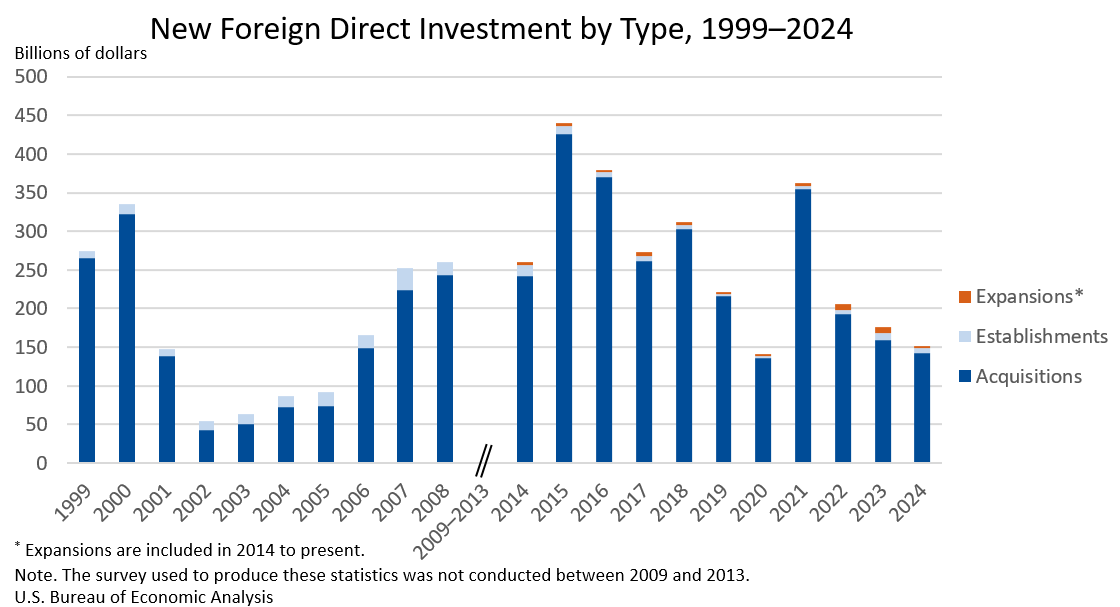Bureau of Economic Analysis
New Foreign Direct Investment in the United States, 2024
Expenditures by foreign direct investors to acquire, establish, or expand U.S. businesses totaled $151.0 billion in 2024, according to preliminary statistics released today by the U.S. Bureau of Economic Analysis. Expenditures decreased $24.9 billion, or 14.2 percent, from $176.0 billion (revised) in 2023 and were below the annual average of $277.2 billion for 2014–2023. As in previous years, acquisitions of existing U.S. businesses accounted for most of the expenditures.
Principal Federal Economic Indicators
Noteworthy
- 2025 News Release Schedule
- Innovation at BEA
- 2025 Annual Updates
- New! Services Trade Data for More Countries
- Data Tool: Trade in Value Added
- Distribution of State Personal Income
- Updated: RIMS II Regional Multipliers
- Arts and Culture
- Space Economy
- FDI Now in State BEARFACTS
- Quick Guide: Price Indexes
The Latest
April 2022 Trade Gap is $87.1 Billion
The U.S. monthly international trade deficit decreased in April 2022 according to the U.S. Bureau of Economic Analysis and the U.S. Census Bureau. The deficit decreased from $107.7 billion in March (revised) to $87.1 billion in April, as exports increased and imports decreased. The previously published March deficit was $109.8 billion. The goods deficit decreased $19.1 billion in April to $107.7 billion. The services surplus increased $1.5…
U.S. International Trade in Goods and Services, Annual Revision
The U.S. monthly international trade deficit decreased in April 2022 according to the U.S. Bureau of Economic Analysis and the U.S. Census Bureau. The deficit decreased from $107.7 billion in March (revised) to $87.1 billion in April, as exports increased and imports decreased. The previously published March deficit was $109.8 billion. The goods deficit decreased $19.1 billion in April to $107.7 billion. The services surplus increased $1.5…
U.S. International Trade in Goods and Services, April 2022
The U.S. monthly international trade deficit decreased in April 2022 according to the U.S. Bureau of Economic Analysis and the U.S. Census Bureau. The deficit decreased from $107.7 billion in March (revised) to $87.1 billion in April, as exports increased and imports decreased. The previously published March deficit was $109.8 billion. The goods deficit decreased $19.1 billion in April to $107.7 billion. The services surplus increased $1.5…
Personal Income and Outlays, April 2022
Personal income increased $89.3 billion, or 0.4 percent at a monthly rate, while consumer spending increased $152.3 billion, or 0.9 percent, in April. The increase in personal income primarily reflected an increase in compensation. The personal saving rate (that is, personal saving as a percentage of disposable personal income) was 4.4 percent in April, compared with 5.0 percent in March.
Personal Income and Outlays, April 2022
Personal income increased $89.3 billion, or 0.4 percent at a monthly rate, while consumer spending increased $152.3 billion, or 0.9 percent, in April. The increase in personal income primarily reflected an increase in compensation. The personal saving rate (that is, personal saving as a percentage of disposable personal income) was 4.4 percent in April, compared with 5.0 percent in March.
Gross Domestic Product, First Quarter 2022 (Second Estimate) Corporate Profits, First Quarter 2022 (Preliminary Estimate)
Real gross domestic product (GDP) decreased at an annual rate of 1.5 percent in the first quarter of 2022, following an increase of 6.9 percent in the fourth quarter of 2021. The decrease was revised down 0.1 percentage point from the “advance” estimate released in April. In the first quarter, there was a resurgence of COVID-19 cases from the Omicron variant and decreases in government pandemic assistance payments. For more details, including…
Gross Domestic Product (Second Estimate) and Corporate Profits (Preliminary), First Quarter 2022
Real gross domestic product (GDP) decreased at an annual rate of 1.5 percent in the first quarter of 2022, following an increase of 6.9 percent in the fourth quarter of 2021. The decrease was revised down 0.1 percentage point from the "advance" estimate released in April. In the first quarter, there was a resurgence of COVID-19 cases from the Omicron variant and decreases in government pandemic assistance payments.
March 2022 Trade Gap is $109.8 Billion
The U.S. monthly international trade deficit increased in March 2022 according to the U.S. Bureau of Economic Analysis and the U.S. Census Bureau. The deficit increased from $89.8 billion in February (revised) to $109.8 billion in March, as imports increased more than exports. The previously published February deficit was $89.2 billion. The goods deficit increased $20.4 billion in March to $128.1 billion. The services surplus increased $0.4…
U.S. International Trade in Goods and Services, March 2022
The U.S. monthly international trade deficit increased in March 2022 according to the U.S. Bureau of Economic Analysis and the U.S. Census Bureau. The deficit increased from $89.8 billion in February (revised) to $109.8 billion in March, as imports increased more than exports. The previously published February deficit was $89.2 billion. The goods deficit increased $20.4 billion in March to $128.1 billion. The services surplus increased $0.4…
Personal Income and Outlays, March 2022
Personal income increased $107.2 billion, or 0.5 percent at a monthly rate, while consumer spending increased $185.0 billion, or 1.1 percent, in March. The increase in personal income primarily reflected an increase in compensation. The personal saving rate (that is, personal saving as a percentage of disposable personal income) was 6.2 percent in March, compared with 6.8 percent in February.




